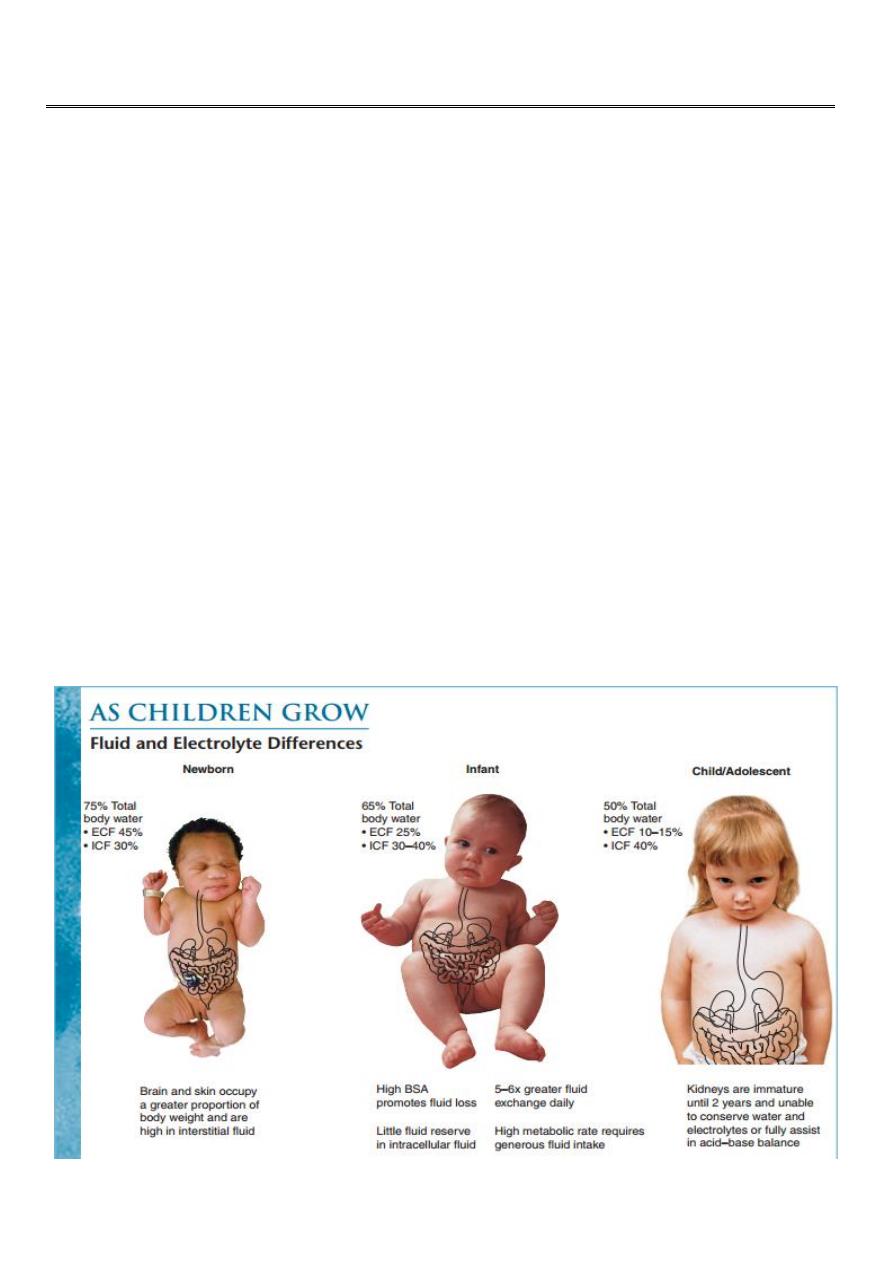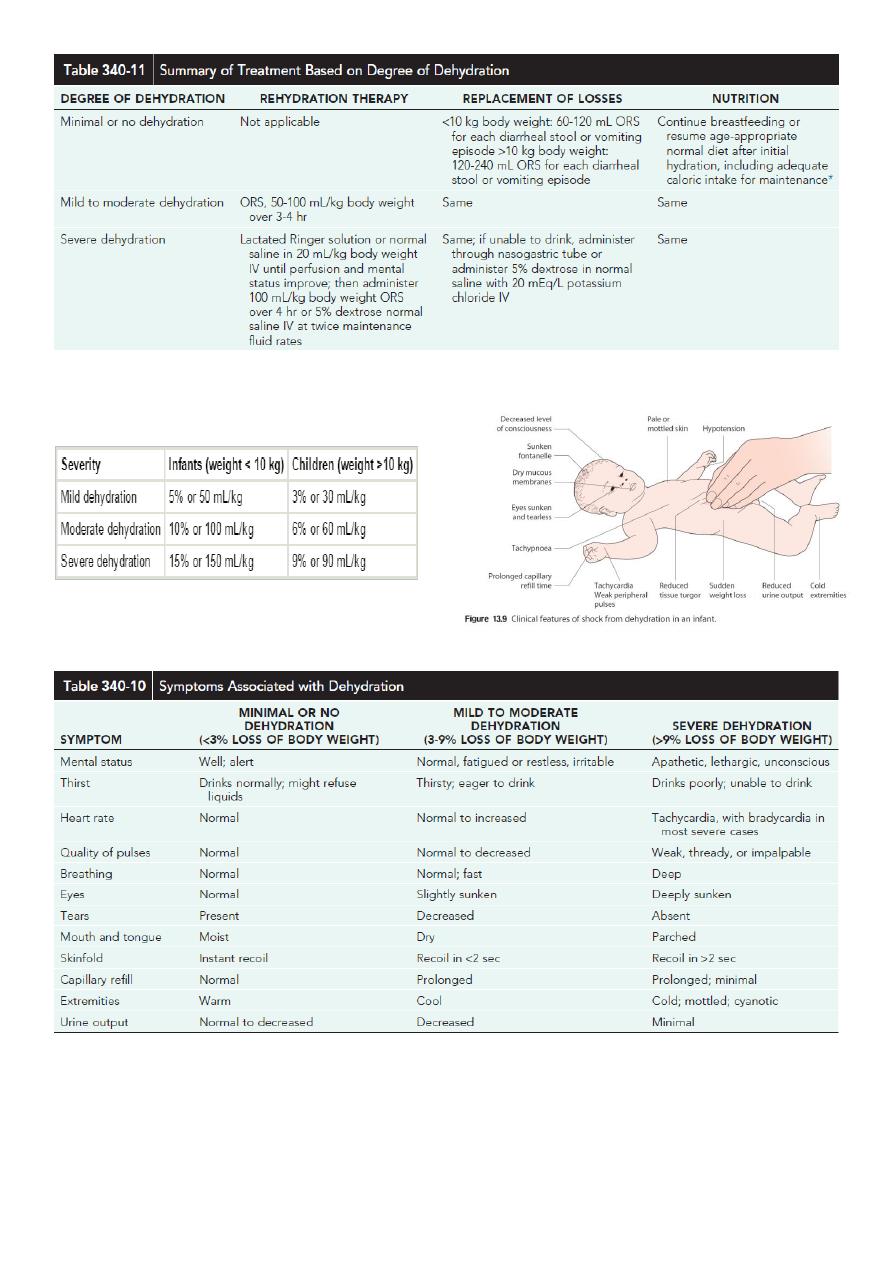
1
Fifth stage
Pediatric
Lec-2
.د
أوس
11/11/2015
DEHYDRATION (total body deficit of sodium and water)
The following children are at increased risk of dehydration:
Infants, particularly those under 6 months of age or those born with low birthweight.
o If they have passed ≥6 diarrhoeal stools in the previous 24 h
o If they have vomited three or more times in the previous 24 h
o If they have been unable to tolerate (or not been offered) extra fluids
o If they have malnutrition
Infants are at particular risk of dehydration because they have a greater surface area to
weight ratio than older children, leading to greater insensible water losses .They have
higher basal fluid requirements (100–120 ml/kg per day, i.e. 10–12% of bodyweight) and
immature renal tubular reabsorption. In addition, they are unable to obtain fluids for
themselves when thirsty.

2

3
ORS
The low-osmolality World Health Organization (WHO) oral rehydration solution (ORS)
containing 75 mEq of sodium, 64 mEq of chloride, 20 mEq of potassium, and 75 mmol
of glucose per liter, with total osmolarity of 245 mOsm/L, is now the global standard of
care and more effective than home fluids, including decarbonated soda beverages,
fruit juices, and tea. These are not suitable for rehydration or maintenance therapy
because they have inappropriately high osmolalities and low sodium concentrations.
Oral rehydration should be given to infants and children slowly, especially if they have
emesis. It can be given initially by a dropper, teaspoon, or syringe, beginning with as
little as 5 mL at a time .The volume is increased as tolerated.
Oral rehydration can also be given by a nasogastric tube if needed; this is not the usual
route.
Limitations to oral rehydration therapy include shock, an ileus, intussusception,
carbohydrate intolerance (rare), severe emesis, and high stool output (>10 mL/kg/hr)
Hypernatraemic dehydration ( sodium concentration >150 mEq/L)
Infrequently, water loss exceeds the relative sodium loss and plasma sodium
concentration increases (hypernatraemic dehydration). This usually results from high
insensible water losses (high fever or hot, dry environment)or from profuse, low-
sodium diarrhea. The extracellular fluid becomes hypertonic with respect to the
intracellular fluid, which leads to a shift of water into the extracellular space from the
intracellular compartment. Signs of extracellular fluid depletion are therefore less per
unit of fluid loss, and depression of the fontanelle, reduced tissue elasticity and sunken
eyes are less obvious. This makes this form of dehydration more difficult to recognise
clinically , particularly in an obese infant.
It is a particularly dangerous form of dehydration as water is drawn out of the brain
and cerebral shrinkage within a rigid skull may lead to jittery movements, increased
muscle tone with hyper reflexia, altered consciousness, seizures and multiple, small
cerebral haemorrhages.
If the serum sodium concentration is lowered rapidly, there is movement of water from
the serum into the brain cells to equalize the osmolality in the 2 compartments . The
resultant brain swelling manifests as seizures or coma.
Because of the associated dangers, hypernatremia should not be corrected rapidly. The
goal is to decrease the serum sodium by <12 mEq/L every 24 hr-- The fluid deficit
should be replaced over at least 48 h and the plasma sodium measured regularly

4
Isonatraemic dehydration (sodium 135-150 meq/l)
the losses of sodium and water are proportional and plasma sodium remains within the
normal range
Most common type
hyponatraemic dehydration: (serum sodium level <135 mEq/L)
When children with diarrhoea drink large quantities of water or other hypotonic
solutions, there is a greater net loss of sodium than water, leading to a fall in plasma
sodium (hyponatraemic dehydration). This leads to a shift of water from extra- to
intracellular compartments. The increase in intracellular volume leads to an increase in
brain volume, which may result in convulsions, whereas the marked extracellular
depletion leads to a greater degree of shock per unit of water loss. This
form of dehydration is more common in poorly nourished infants in developing
countries.
Severe dehydration (TREATMENT)
Phase 1 : focuses on emergency management. Severe dehydration is characterized by
a state of hypovolemic shock requiring rapid treatment. Initial management includes
placement of an intravenous or intraosseous line and rapid administration of 20 mL/kg
of an isotonic crystalloid (eg, lactated Ringer solution, 0.9% sodium chloride).
Additional fluid boluses may be required depending on the severity of the dehydration.
The child should be frequently reassessed to determine the response to treatment. As
intravascular volume is replenished, tachycardia, capillary refill, urine output, and
mental status all should improve. If improvement is not observed after 60 mL/kg of
fluid administration, other etiologies of shock (eg, cardiac, anaphylactic, septic) should
be considered. Hemodynamic monitoring and inotropic support may be indicated.
Phase 2: focuses on deficit replacement, provision of maintenance fluids, and
replacement of ongoing losses. Maintenance fluid requirements are equal to measured
fluid losses (urine, stool) plus insensible fluid losses. Normal insensible fluid loss is
approximately 400-500 mL/m2 body surface area and may be increased by factors such
as fever and tachypnea.
Alternatively, daily fluid requirements may be roughly estimated as follows:
Less than 10 kg = 100 mL/kg
10-20 kg = 1000 + 50 mL/kg for each kg over 10 kg
Greater than 20 kg = 1500 + 20 mL/kg for each kg over 20 kg
Severe dehydration by clinical examination suggests a fluid deficit of 10-15% of body
weight in infants and 6-9% of body weight in older children. The daily maintenance

5
fluid is added to the fluid deficit. In general, the recommended administration is one
half of this volume administered over 8 hours and administration of the remainder
over the following 16 hours. Continued losses (eg, emesis, diarrhea) must be promptly
replaced.
If the child is isonatremic (130-150 mEq/L), the sodium deficit incurred can generally be
corrected by administering the fluid deficit plus maintenance as 5% dextrose in 0.45-
0.9% sodium chloride. Potassium (20 mEq/L potassium chloride) may be added to
maintenance fluid once urine output is established and serum potassium levels are
within a safe range.
Enteral Feeding and Diet Selection
Continued enteral feeding in diarrhea aids in recovery from the episode, and a
continued age-appropriate diet after rehydration is the norm.
Once rehydration is complete, food should be reintroduced while oral rehydration is
continued to replace ongoing losses from emesis or stools and for maintenance.
Breastfeeding or non diluted regular formula should be resumed as soon as possible.
Foods with complex carbohydrates (rice, wheat, potatoes, bread, and cereals), lean
meats, yogurt, fruits, and vegetables are also tolerated
Fatty foods or foods high in simple sugars (juices, carbonated sodas) should be avoided
Zinc Supplementation
Zinc administration for diarrhea management can significantly reduce all cause
mortality by 46% and hospital admission by 23%. Also reduce duration and severity of
diarrhea
All children older than 6 mo of age with acute diarrhea in at-risk areas should receive
oral zinc (20 mg/day) in some form for 10-14 days during and continued after diarrhea
Additional Therapies
The use of probiotic nonpathogenic bacteria for prevention and therapy of diarrhea has
been successful in some settings
Saccharomyces boulardii is effective in antibiotic-associated and in C. difficile diarrhea,
and there is some evidence that it might prevent diarrhea in daycare centers.
Lactobacillus rhamnosus GG is associated with reduced diarrheal duration and severity,
which reduction is more evident in cases of childhood rotavirus diarrhea

6
Antimotility agents (loperamide) are contraindicated in children with dysentery and
probably have no role in the management of acute watery diarrhea in otherwise
healthy children.
Because persistent vomiting can limit oral rehydration therapy, a single sublingual dose
of an oral dissolvable tablet of ondansetron (4 mg 4-11 yr and 8 mg for children older
than 11 yr [generally 0.2 mg/kg]) may be given.However, most children do not require
specific antiemetic therapy;careful oral rehydration therapy is usually sufficient.
Antibiotic Therapy
antibiotic therapy in select cases of diarrhea related to bacterial infections can reduce
the duration and severity of illness and prevent complications
Although these agents are important to use in specific cases, their widespread and
indiscriminate use leads to the development of antimicrobial resistance.
PREVENTION
1- Promotion of Exclusive Breastfeeding (administration of no other fluids or foods for the
1st 6 mo of life)
2- Improved Complementary Feeding Practices
3- Rotavirus Immunization
4- Improved Water and Sanitary Facilities and Promotion of Personal and Domestic
Hygiene
5- Improved Case Management of Diarrhea
Complications
(Extraintestinal Manifestations of Enteric Infections)
1- Focal infections from systemic spread of bacterial pathogens, includingvulvovaginitis,
urinary tract infection,endocarditis, osteomyelitis, meningitis,pneumonia, hepatitis,
peritonitis,chorioamnionitis, soft-tissue infection,and septic thrombophlebitis
2- Reactive arthritis
3- Guillain-Barré syndrome
4- Glomerulonephritis
5- Immunoglobulin A (IgA) nephropathy
6- Erythema nodosum
7- Hemolytic uremic syndrome: Escherichia coli O157:H7
8- Hemolytic anemia
